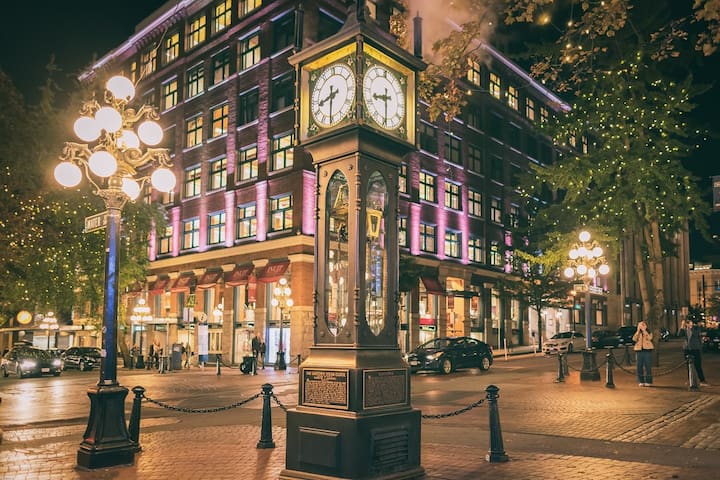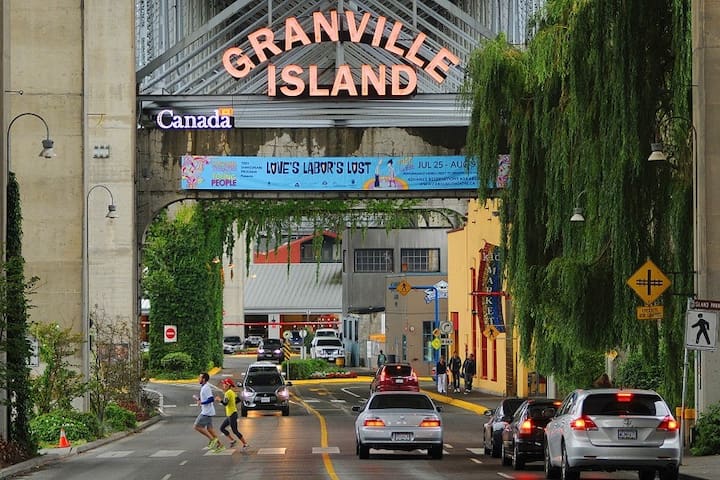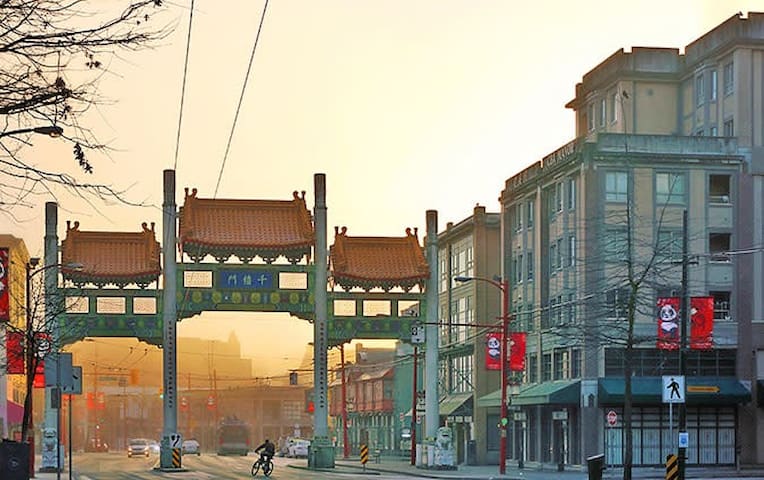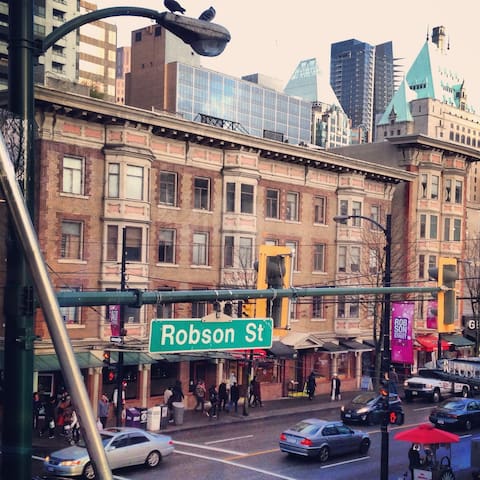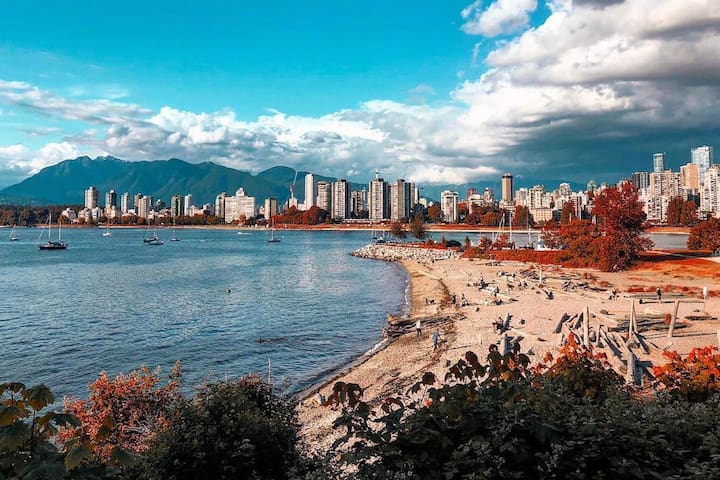Sightseeing
Vancouver’s oldest neighborhood, Gastown grew from a single tavern founded by John ‘Gassy Jack’ Deighton back in 1867. Today, the district retains its historic charm and independent spirit. Victorian architecture houses a thriving fashion scene, impeccably curated décor boutiques, one-of-a-kind galleries and some of the best culinary fare in Vancouver. It’s a gathering place for stylish locals and an ideal neighborhood to explore on foot.
Gastown is a neighborhood that seamlessly combines old with new, history with the way forward. An essential part of Vancouver’s history, a visit to Gastown should include a stroll along Water Street, where you’ll find a picture-perfect collection of old buildings, cobblestones, the Steam Clock, and vintage lampposts. Continue to the end of Water Street to visit a statue of the man who started it all, Gassy Jack Deighton. Architecture and history buffs can take organized walking tours of the area to further explore. Get a bird’s eye view of the area from the Vancouver Lookout, which rises 167-metres (548-feet) to give visitors a 360˚ panorama of the city.
1068 preporuka/e lokalaca
Gastown
Vancouver’s oldest neighborhood, Gastown grew from a single tavern founded by John ‘Gassy Jack’ Deighton back in 1867. Today, the district retains its historic charm and independent spirit. Victorian architecture houses a thriving fashion scene, impeccably curated décor boutiques, one-of-a-kind galleries and some of the best culinary fare in Vancouver. It’s a gathering place for stylish locals and an ideal neighborhood to explore on foot.
Gastown is a neighborhood that seamlessly combines old with new, history with the way forward. An essential part of Vancouver’s history, a visit to Gastown should include a stroll along Water Street, where you’ll find a picture-perfect collection of old buildings, cobblestones, the Steam Clock, and vintage lampposts. Continue to the end of Water Street to visit a statue of the man who started it all, Gassy Jack Deighton. Architecture and history buffs can take organized walking tours of the area to further explore. Get a bird’s eye view of the area from the Vancouver Lookout, which rises 167-metres (548-feet) to give visitors a 360˚ panorama of the city.
In the early 1900s, Granville Island was home to factories, plants and sawmills. Things are a little different today—Granville Island is both a locals’ favorite and a huge draw for visitors. Technically a sandspit and not an island, the neighbourhood sits just south of the downtown peninsula, right under the Granville Bridge. The Granville Island Public Market acts as a hub of activity, but it’s also one of the city’s most important cultural districts with theatres, artisan workshops and craft studios.
One of the best ways to get to Granville Island is one of the adorable mini-tugboat ferries that criss-cross False Creek – they’re favourites among young and old! Once you’re there, the biggest attraction on Granville Island is the Public Market. Housed indoors, there are endless rows of stalls that feature fresh produce, gourmet foods, baked goods, and seafood. For the food-focused, a walking tour of the market can be a great way to get an insider’s insight. Outside of the market, catch a show at one of the many theatres on the island, browse an art gallery show, or appeal to your outdoorsy side with a kayaking or paddleboarding tour.
1659 preporuka/e lokalaca
Otok Granville
In the early 1900s, Granville Island was home to factories, plants and sawmills. Things are a little different today—Granville Island is both a locals’ favorite and a huge draw for visitors. Technically a sandspit and not an island, the neighbourhood sits just south of the downtown peninsula, right under the Granville Bridge. The Granville Island Public Market acts as a hub of activity, but it’s also one of the city’s most important cultural districts with theatres, artisan workshops and craft studios.
One of the best ways to get to Granville Island is one of the adorable mini-tugboat ferries that criss-cross False Creek – they’re favourites among young and old! Once you’re there, the biggest attraction on Granville Island is the Public Market. Housed indoors, there are endless rows of stalls that feature fresh produce, gourmet foods, baked goods, and seafood. For the food-focused, a walking tour of the market can be a great way to get an insider’s insight. Outside of the market, catch a show at one of the many theatres on the island, browse an art gallery show, or appeal to your outdoorsy side with a kayaking or paddleboarding tour.
Established back in the 1890s, Vancouver’s Chinatown has been humming busily for more than a century with vivid colours, exotic cuisine and a vibrant culture. Vancouver’s Chinese population originally made the journey to work in local mines and build the Trans-Canada railway. Rich in history and architecture, this area east of downtown boasts North America's third-largest Chinatown after New York and San Francisco. The main commercial area runs is around six blocks, bordered by East Pender Street, Gore Avenue, East Georgia Street, and Carrall Street.
It’s easy to spend a half-day in Chinatown. No visit is complete without spending time at Dr. Sun Yat-Sen Classical Chinese Garden—the first of its kind to ever be built in Canada. Along with being a beautiful garden, it offers a fascinating primer on Chinese culture and symbolism. The world’s narrowest commercial building, the Sam Kee Building at the corner of Pender and Carrall, is also worth a look. But the best thing about spending time in Chinatown is strolling the commercial district, and experiencing the neighbourhood with all five senses. The area is also home to the Vancouver Chinatown Festival in August each year.
171 preporuka/e lokalaca
Chinatown
Established back in the 1890s, Vancouver’s Chinatown has been humming busily for more than a century with vivid colours, exotic cuisine and a vibrant culture. Vancouver’s Chinese population originally made the journey to work in local mines and build the Trans-Canada railway. Rich in history and architecture, this area east of downtown boasts North America's third-largest Chinatown after New York and San Francisco. The main commercial area runs is around six blocks, bordered by East Pender Street, Gore Avenue, East Georgia Street, and Carrall Street.
It’s easy to spend a half-day in Chinatown. No visit is complete without spending time at Dr. Sun Yat-Sen Classical Chinese Garden—the first of its kind to ever be built in Canada. Along with being a beautiful garden, it offers a fascinating primer on Chinese culture and symbolism. The world’s narrowest commercial building, the Sam Kee Building at the corner of Pender and Carrall, is also worth a look. But the best thing about spending time in Chinatown is strolling the commercial district, and experiencing the neighbourhood with all five senses. The area is also home to the Vancouver Chinatown Festival in August each year.
This magnificent 404-hectare park combines excellent attractions with a mystical natural aura. Don’t miss a stroll or a cycle (rentals near the W Georgia St entrance) around the 8.8km seawall: a kind of visual spa treatment fringed by a 150,000-tree temperate rainforest, it’ll take you past the park’s popular totem poles and alongside its shimmering oceanfront.
2658 preporuka/e lokalaca
Stanley Park
610 Pipeline RdThis magnificent 404-hectare park combines excellent attractions with a mystical natural aura. Don’t miss a stroll or a cycle (rentals near the W Georgia St entrance) around the 8.8km seawall: a kind of visual spa treatment fringed by a 150,000-tree temperate rainforest, it’ll take you past the park’s popular totem poles and alongside its shimmering oceanfront.
With BC Place Stadium at one end, Stanley Park at the other, and the city’s best-known shopping precinct in between, Robson Street is a must-stroll for most visitors to Vancouver. One of Vancouver’s oldest commercial streets, it was once known as Robsonstrasse for the sheer number of German and European stores that opened up after the Second World War. The international character of the street still exists. Being right in the heart of the downtown core, you’ll find yourself walking right alongside locals on their way to the office, sports fans heading to the game, and Asian students lining up outside noodle shops.
In keeping with Robson Street’s historically international flavour, you’ll find a bit of everything along the strip. Down at the east end, you’ll find plenty of casual eateries, perfect for a burger and a beer before the game, replete with big screen TVs in case you weren’t able to score a ticket. Towards the middle of Robson, you’ll find some excellent higher-end option, many of which are above street-level, giving you a good perch for some people watching. Head further west towards Stanley Park and you’ll find an excellent choice of well-priced Asian restaurants, packed with locals. Try an izakaya—similar to a Japanese pub, explore Korean cuisine, or slurp your way through a bowl of ramen. If you’re looking for a caffeine refueling you won’t have to walk far; every fourth storefront along Robson appears to be a café.
Shopping is what Robson Street is famous for. Whether you’re looking to give your credit card a thorough workout, or window shopping is more your speed, Robson Street will hit the spot. The main retail shopping area starts around Granville Street, which is where you’ll find the Nordstrom department store and the entrance to the Pacific Centre shopping mall, stretching down to Jervis Street. In between, you’ll find most of the major North American fashion brands, along with a lively mix of sporting goods, accessories, homewares, beauty and wellness purveyors. You’ll find a number of international luxury brands a block off Robson, around the intersection of Burrard and Alberni streets.
789 preporuka/e lokalaca
Robson Street
1155 Robson StWith BC Place Stadium at one end, Stanley Park at the other, and the city’s best-known shopping precinct in between, Robson Street is a must-stroll for most visitors to Vancouver. One of Vancouver’s oldest commercial streets, it was once known as Robsonstrasse for the sheer number of German and European stores that opened up after the Second World War. The international character of the street still exists. Being right in the heart of the downtown core, you’ll find yourself walking right alongside locals on their way to the office, sports fans heading to the game, and Asian students lining up outside noodle shops.
In keeping with Robson Street’s historically international flavour, you’ll find a bit of everything along the strip. Down at the east end, you’ll find plenty of casual eateries, perfect for a burger and a beer before the game, replete with big screen TVs in case you weren’t able to score a ticket. Towards the middle of Robson, you’ll find some excellent higher-end option, many of which are above street-level, giving you a good perch for some people watching. Head further west towards Stanley Park and you’ll find an excellent choice of well-priced Asian restaurants, packed with locals. Try an izakaya—similar to a Japanese pub, explore Korean cuisine, or slurp your way through a bowl of ramen. If you’re looking for a caffeine refueling you won’t have to walk far; every fourth storefront along Robson appears to be a café.
Shopping is what Robson Street is famous for. Whether you’re looking to give your credit card a thorough workout, or window shopping is more your speed, Robson Street will hit the spot. The main retail shopping area starts around Granville Street, which is where you’ll find the Nordstrom department store and the entrance to the Pacific Centre shopping mall, stretching down to Jervis Street. In between, you’ll find most of the major North American fashion brands, along with a lively mix of sporting goods, accessories, homewares, beauty and wellness purveyors. You’ll find a number of international luxury brands a block off Robson, around the intersection of Burrard and Alberni streets.
In the 1960s, beachside Kitsilano was Vancouver's hippy hangout, drawing comparisons to San Francisco's Haight-Ashbury. Today, Kitsilano still has plenty of culture, but its apartments and houses are now occupied by young urban professionals and families who enjoy a modern version of that relaxed atmosphere – this is the birthplace of global yoga brand, lululemon athletica. Just over the Burrard Bridge from the downtown peninsula, the neighbourhood brings together a collection of attractions, beach and parks, residential streets, and a couple of main commercial districts. “Kits,” as it’s known locally, is bordered by the waterfront to the north and West 16th Ave to the south; Burrard Street to the east and Alma Street to the west. Most of the commercial activity is along West 4th Avenue and West Broadway, but you’ll also find shops and restaurants in the areas close to the beach.
From Burrard Bridge, look north and you’ll glimpse a large waterfront greenspace known as Vanier Park. This spot is home to some of Vancouver’s best family-friendly attractions including the Museum of Vancouver, H.R. MacMillan Space Centre, and the Vancouver Maritime Museum, as well as being the venue for the Bard on the Beach Shakespeare festival from June to September each year. Continue along the waterfront and you’ll hit Kitsilano Beach, which is a hotspot during summer, complete with volleyball tournaments, picnicking families, lots of the beautiful people on parade, and the mammoth Kitsilano Pool – an outdoor saltwater public pool right by the beach. The neighbourhoods also host a number of community festivals over the course of the summer including Greek Days on West Broadway, and the Khatsalano Festival centred around West 4th Avenue.
190 preporuka/e lokalaca
Kitsilano
In the 1960s, beachside Kitsilano was Vancouver's hippy hangout, drawing comparisons to San Francisco's Haight-Ashbury. Today, Kitsilano still has plenty of culture, but its apartments and houses are now occupied by young urban professionals and families who enjoy a modern version of that relaxed atmosphere – this is the birthplace of global yoga brand, lululemon athletica. Just over the Burrard Bridge from the downtown peninsula, the neighbourhood brings together a collection of attractions, beach and parks, residential streets, and a couple of main commercial districts. “Kits,” as it’s known locally, is bordered by the waterfront to the north and West 16th Ave to the south; Burrard Street to the east and Alma Street to the west. Most of the commercial activity is along West 4th Avenue and West Broadway, but you’ll also find shops and restaurants in the areas close to the beach.
From Burrard Bridge, look north and you’ll glimpse a large waterfront greenspace known as Vanier Park. This spot is home to some of Vancouver’s best family-friendly attractions including the Museum of Vancouver, H.R. MacMillan Space Centre, and the Vancouver Maritime Museum, as well as being the venue for the Bard on the Beach Shakespeare festival from June to September each year. Continue along the waterfront and you’ll hit Kitsilano Beach, which is a hotspot during summer, complete with volleyball tournaments, picnicking families, lots of the beautiful people on parade, and the mammoth Kitsilano Pool – an outdoor saltwater public pool right by the beach. The neighbourhoods also host a number of community festivals over the course of the summer including Greek Days on West Broadway, and the Khatsalano Festival centred around West 4th Avenue.
See the spot where the 2010 Winter Olympics took place and meet The Birds, giant sparrow sculptures by artist Myfanwy MacLeod that returned to roost here in August 2018 after being flown to Calgary and China to receive repairs. Found between Manitoba Street, Salt Street, Walter Hardwick Avenue and Athletes Way, the Square is a great place to people-watch and is the hub for restaurants and cafes.
83 preporuka/e lokalaca
Olympic Village Square
See the spot where the 2010 Winter Olympics took place and meet The Birds, giant sparrow sculptures by artist Myfanwy MacLeod that returned to roost here in August 2018 after being flown to Calgary and China to receive repairs. Found between Manitoba Street, Salt Street, Walter Hardwick Avenue and Athletes Way, the Square is a great place to people-watch and is the hub for restaurants and cafes.

